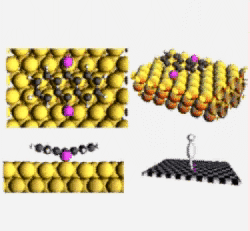A single molecule that waddles in a straight line across a surface has been designed and synthesised by US researchers. The compound, 9,10-dithioanthracene (DTA), could be used as a nanoscopic guiding ratchet for molecular scale devices or as a switching unit for molecular information processing.
Ludwig Bartels and his colleagues, Ki-Young Kwon, Kin Wong and Greg Pawin, at the University of California at Riverside, guided by theorists Sergey Stolbov and Talat Rahman of Kansas State University, created DTA so that it would have two feet and could stand erect on a standard copper surface of the kind used in microelectronics manufacturing, but with only one foot on the surface at a time.

Ludwig Bartels
Heating a molecule would normally send it jiggling in a random direction, not so the DTA, gentle heating or a nudge with the tiny tip of a scanning tunnelling microscope pushes it to put its other foot down and pull up the first and continue doing so indefinitely, walking soberly in a straight line across the flat copper surface. The researchers explain that the planted foot not only supports the molecule but stops it from veering or stumbling off course. The natural crystalline surface of the copper is enough to keep the DTA on course.
Bartels explains that he and his colleagues have observed the walking molecule taking some 10000 steps without once faltering. The molecule could be used to guide the movement of other molecules or alternatively act as a switching device for information storage or even computation. Indeed, almost a decade ago, researchers at IBM Zurich proposed that the position of molecules along a line on a surface could be used to encode numbers in a manner analogous to beads on an abacus. However, scientists had no way of manufacturing the bars of the abacus. The molecules we made do not require any ‘bars’, explains Bartels, because they are restricted to linear motion by their interaction with the substrate.

Sulphur feet allow DTA to walk in a straight line on a flat copper surface (Credit: Bartels)
The researchers are now hoping to develop a variation on the DTA theme that can convert thermal energy directly into motion. Thermal energy is actually just another word for the motion of atoms and molecules, adds Bartels. DTA moves along one line, but it can go forward and backward. Currently, we are trying to modify it, so that it will only go forward using asymmetric substitution of the molecule. Also, we plan to modify DTA so that it can carry molecules across a surface, he told Spotlight.

Walking animation (1MB animation) (Credit: Bartels)
Further reading
Phys. Rev. Lett. 95, 166101
Bartels Group
http://research.chem.ucr.edu/groups/bartels/